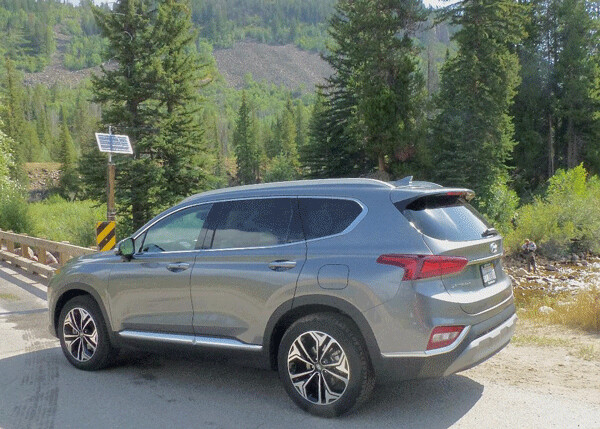New Santa Fe handles with slot-car precision
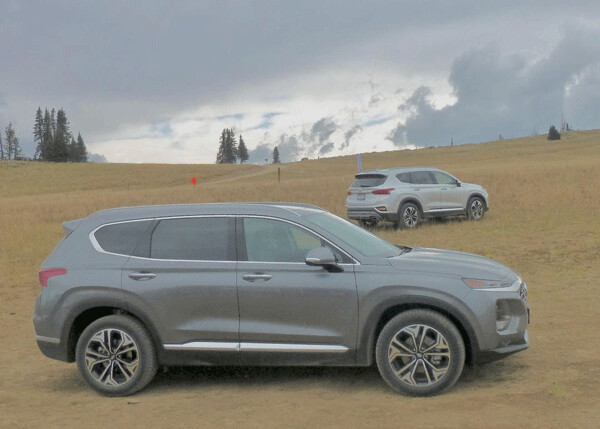
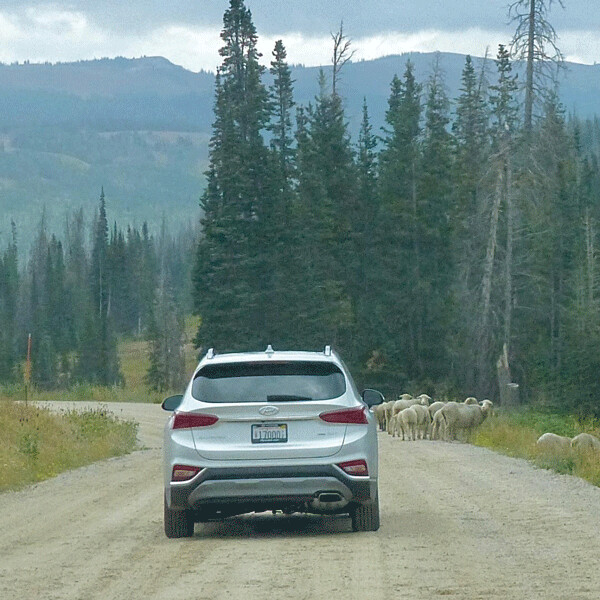
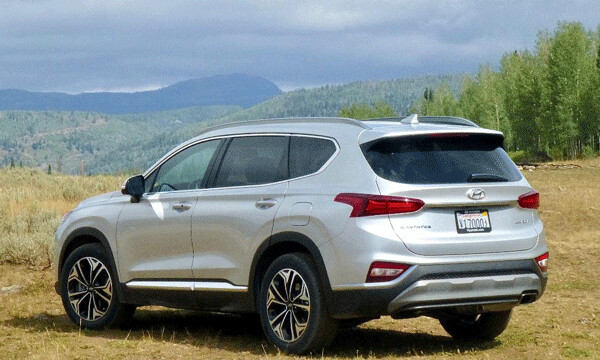
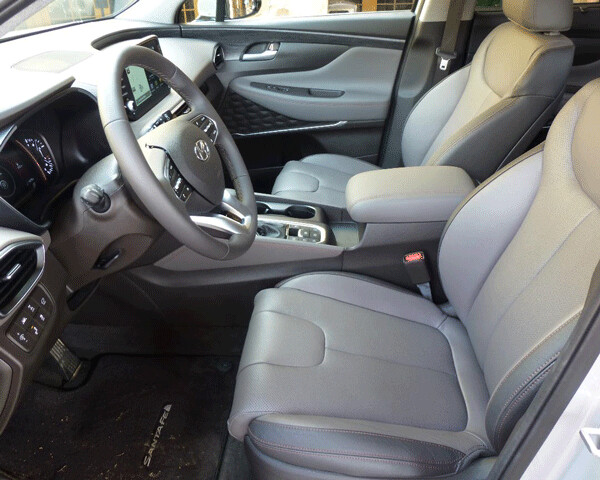
PARK CITY, UTAH
Hyundai displayed its latest concepts of all-wheel drive, all-new suspension fore and aft, variable driving modes, and computer-perfected lane-keeping assistance - all at the same time - which I discovered quite unintentionally while gently guiding a 2019 Santa Fe around some tight curves at nearly 10,000 feet of altitude.
I say unintentional, because I’ve driven many vehicles with all-wheel drive, many with adjustable driving modes, and nearly everything nowadays with some form of lane-guidance or assist, and they have been mostly impressive. But firmly encapsulated in the driver’s seat of a 2019 Hyundai Santa Fe that I was pushing toward its limits on a high mountain 2-lane was not where I expected to find all those features operating in concert.
The new redesigned and re-engineered Santa Fe is increased in torsional stiffness from 27.2 to 31.5 in its resistance to twisting, with new structured angles and configuration of suspension pieces, body structure altered from 58 percent to 67 percent high-grade steel, and advanced aerospace adhesives, all conspired to lower Santa Fe’s weight by 52 pounds over the current model. The H-Trac all-wheel-drive system is located between the axles with electric servo operating a torque-vectoring system to coordinate the front and rear axles in their projected swath around curves.
Greatly reduced friction in the new Hyundai-designed 8-speed automatic makes it work more efficiently and with overlapping ratios above and below the current 6-speed transmission. When you switch modes from “normal” past “smart” and into “sport,” you have altered the steering, suspension, and shift-points to an immediately noticeable sporty feeling of control. The H-Trac, steering mechanism and torque-vectoring makes the system anticipate the need to turn much quicker, making it feel more predictive than reactive. Simply put, it has quicker-steering response while the suspension holds it flat.
Meanwhile, the lane settings might be aimed for safety or staying on the road, with four levels. The first lets you touch the lane side markings before warning you, the next assists you in staying off the side line, and as you make it more controlling, the fourth level actually uses four ultrasonic sensors, two high-frequency sensors and four other cameras monitoring the vehicle and gently but surely keeping you equidistant from the inside and outside lines. It wants you to be centered in the lane, and it offers definite assist to keep you there.
Now, combine that with all the upgraded and coordinated handling features, and what you have is a vehicle that can be driven quite hard around serious curves, and while it reacts instantly to your steering touch, it also keeps you centered in your lane.
We had an odd number of drivers on our wave, so, by luck, I was driving with Miles Johnson, a Hyundai official who knows pretty much about every model. Not only was that good for me to learn the Santa Fe’s nuances, it also meant that - oh darn! - I would get to drive the entire 176 miles.
My only manipulation is that I am annoyed by SUV-like vehicles with only front-wheel drive, so I wanted to be sure to be driving the all-wheel-drive Santa Fe, which meant we were in a gorgeous gray Santa Fe Ultimate, with the 2.0-liter turbocharged 4-cylinder engine, with 235 horsepower and 260 foot-pounds of
torque that come on full at a mere 1,450 RPMs. The alternative is the 2.4-liter, larger but without a turbo, which has 185 horsepower and 178 foot-pounds of torque.
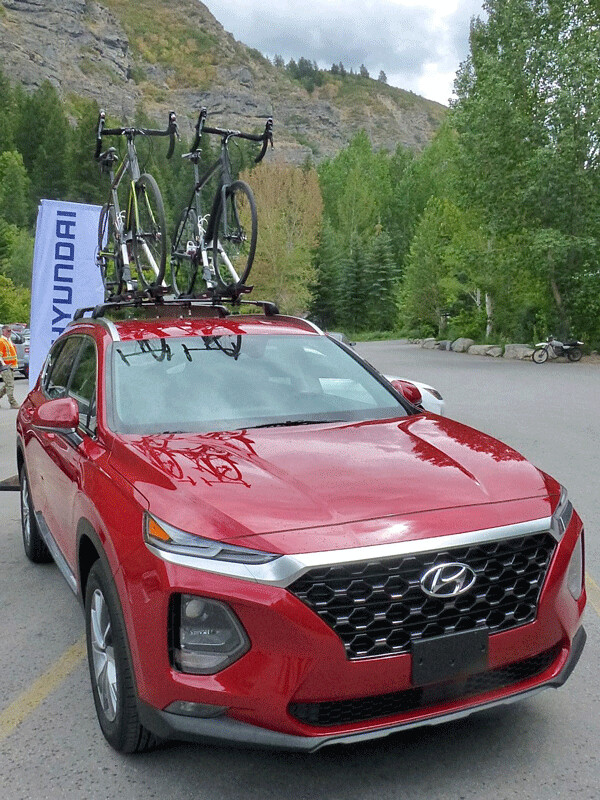
I had to comment to Miles that the Santa Fe handled with such amazing precision that it felt like handling a slot car on a game-room track.
We also spent some time on rough gravel roads, and finally got to a rugged hill-climb area where we had the chance to try to make it up a lengthy, steep, uphill gravel road, rutted and rough and muddy in parts. Such challenges are a lot like trying to make it up an icy avenue in Duluth on a January morning. We left it in drive, shifted the terrain setting to lock in the all-wheel-drive system, and hit it. No problem.
When the Santa Fe came out as the most prominent member of Hyundai’s array of SUVs in 2000, it was the South Korean company’s first serious attempt at taking on the newly expanding interest in building truck-like vehicles to haul more stuff than just a family of four.
Nobody, including Hyundai, could have foreseen the incredible popularity of SUV, although it kept pace very well, having just introduced an impressive small SUV called the Kona, to join the compact Tucson, and the larger pair of the Santa Fe and the smaller Santa Fe Sport. It is time to adjust the group, for 2019, which again thrusts the Santa Fe into prominence. Technically, the new Santa Fe replaces the Santa Fe Sport as a compact, while the larger sibling will stretch into the midsize segment as the Santa Fe XL, with three rows of seats.
The face of Hyundai SUVs all had what they called a “cascading” grille, with horizontal rows of silver bars that made that concept readily identifiable and attractive. The new Kona was a surprising change, and it led the way to the entire field of Hyundai SUVs to adopt the new signature look. While mostly a pattern of black openings gathered within the familiar outline shape, Hyundai is still identifying it as cascading.
Our introductory test drive of the 2019 Hyundai Santa Fe was held at the
luxurious but rustic Stein Eriksen Resort in the mountains near Park City, Utah, which is just to the east of Salt Lake City. From there we drove skyward, around curvy highways up to an altitude of 9,753 feet. We descended back down similar roadways for a lunch stop at Robert Redford’s Sundance resort, which has made its own name for indie film competitions. Word is that Redford built his mountain enclave in the area where he could also offer its spectacular scenery and terrain for such classics as Jeremiah Johnson.
When our drive started, the first thing I noticed along with the precise steering was the near silence of our interior. Insulation in the fenders and padding on various parts of the floor are augmented by thicker laminated glass.
Hyundai officials stressed the safety inherent in every Santa Fe, from the least-expensive $25,300 SE, to the $27,680 SEL, to the $29,800 SEL Plus with leather, to the $32,600 Limited, and to the $35,450 Ultimate.
Standard features are forward collision avoidance assist; blind-spot avoidance assist; lane-keeping assist; cross-traffic avoidance; safe exit assistance; hihg-beam assist; smart cruise with stop-and-go; and driver attention warning.
As you move up in models, avoiding the multiple-choice plan of adding options piecemeal, you get refinements that set the Santa Fe apart. For example, along with back-up warning, you get a rear exit assist, which prevents a rear-seat occupant from opening the rear door if the Santa Fe notes that a car is approaching on that side to pass. Same if a child or pet is in the rear seat and the driver locks the vehicle and runs inside a store. Any movement by the child or pet will caust an alert to sound on your smartphone, and the horn honks.
If that’s all futuristic over an above the now-familiar heads-up display, wireless charger, heated and ventilated front seats, surround view when parking, rain-sensing wipers, panoramic sun roof, rear sunshades, music restoration on the Infinity sound system with music restoration, that’s what you have available on the new Santa Fe.
After we had returned to our Stein Eriksen home base for dinner, I couldn’t help bringing up the amazement I registered with the combined lane-keep centering and the sport handling, but at least half a dozen of my fellow journalists cut me off and said, “Oh, I switched the lane-keep off.”
You see, we car-testing journalists love to act like we’re better drivers than the norm, so we don’t want any car assisting us. I said with the Santa Fe, that was a mistake. “Maybe,” I said, “you just didn’t want the car pointing out how often you veer across the white line. Because a professional road-racer driving hard in a new Santa Fe would say, ‘I’ve been trying to do that my whole career?’ ”
Clad in all-new sheet metal on the outside and completely redesigned interior, as well as a much more rigid platform and all the driving-assist stuff, the new Santa Fe is the perfect example of how a high-tech company can build a safe, solid vehicle bristling with all of the latest electronic features. It may be the perfect compromise of a smooth and comfortable family hauler that is ready, willing and able to go off-roading with Jeep-like performance.
